There can be a temptation, when looking at buying a cruising boat, to go a little bit large, and get a bit more than you really need. The new Beneteau Oceanis 34.1 offers its new owners everything they need in a tidy package, offering plenty of features packed into a manageable-size boat.
For example, on boat just over 35-feet long (the 34.1 is 10.77m LOA), you’re unlikely to need three separate double-berth cabins, so this boat comes standard with two generous cabins (three optional). You don’t really need two heads, either, so that space can be better utilised to provide a separate shower compartment.

Storage space is always to be at a premium, so why not convert the port quarterberth into something really practical and usable, like a handy ‘garage’ for stashing sails and water toys? And how often do you need to use the chart table? Wouldn’t it be practical to have it fold up out of the way most of the time, meaning the settee can be a decent length and act as an extra berth as required?

It’s this kind of smart thinking that has gone into the interior design of the new-generation Oceanis 34.1, along with the naval architecture team (led by the late Marc Lombard) making refinements to the hull shape, such as adding extra width at the bow for better upwind balance, and reducing the wetted surface. The monolithic hull has a hard chine to help with stability, but has fortunately avoided the hard-edged, boxy look at the transom by softening it out as it moves aft.
The new-gen boat is a bit narrower than the model it replaces, and its construction has been tweaked to make it considerably lighter, to improve sailing performance. Topped off with a curved sheerline, and on this boat an attractive pearl-grey hull finish, it makes for a smart-looking package, well-proportioned and with none of the blockiness that can be generated when drawing a shorter yacht with generous volume.

This boat is set up in cruising mode, for the owner and his wife to sail as a couple, and maybe host the occasional guest. They wanted it to be as easy as possible to set up and sail, hence their choice of a furling main and jib, which are easy to deploy and pack away without anyone needing to go forward. If you are after something this size but more performance-orientated, there is a First Line version of this model available, which has a larger rig and a much deeper, hydraulic lifting keel.
As a comfortable cruiser, this model is not designed to have masses of sail area; the base version comes with a small, 17.1m2s elf-tacking jib and a stackpack for the 31.4m2 main. On this boat, for ease of use but just a bit more performance, the owner has opted for an in-mast furling mainsail (reducing its area to 26.2m2) and 106% overlapping genoa (23.3m2).

The boat also has a substantial, solid-looking fixed prod, with a Dyneema bobstay, from which a code zero or asymmetric downwind sail can be flown. The Delta anchor sits at an angle to this, poised in its bow roller, backed up by a decent-sized chain locker with an electric winch that can be controlled remotely.
What’s nice about the solid Seldén rig with its two pairs of heavily swept spreaders is that it means no backstays are required, so the transom is completely unobstructed. When at anchor, the back of the boat can be opened right up by lowering the boarding platform and folding up the helm seats each side, to allow unimpeded access to the water.

There’s no traveller in the cockpit either: the mainsheet comes down off the boom to a bridle forward of the dodger, then runs in a German system to sheet at the pair of Harken cabintop winches, one of which is powered. The genoa sheets back to an additional pair of winches on the cockpit coamings through friction rings on the cabintop, which act like in- or outhauls to adjust the trim position (instead of tracks). The boat has nifty Spinlock PXR cam cleats on these genoa sheets, which act like a jammer but are easier to deploy and release, using a lift-and-drop rocking action.
A generous-height dodger, which links to a bimini at the transom with a zip-in panel, provides much-needed shade for the cockpit. The dodger gives plenty of headroom for whoever is operating the keyboards and/or trimming using the pair of winches on the cabintop, while big clear panels mean visibility is not compromised.

There’s one other slightly unusual feature on this boat: because the owner has opted for in-mast furling, it is set up with a ratchet winch on the mast foot. This enables the continuous-loop luff line on the main to be controlled when the ratchet is on (so it can only run one way), and is designed to be a safety feature when reefing or furling in fresh conditions. My guess is that you wouldn’t need to use it very often, but it could come in handy if the crew were caught out in a sudden change of conditions.
Otherwise, there’s a degree of ‘set it and forget it’ – let the boat pretty much sail itself while the crew relax in comfort. The back end of the boat is all party, with very little ‘sailing’ paraphernalia in it, aside from the obvious big wheels, which are positioned well aft and outboard.

The cockpit has a central table with timber ‘chopping block’-style leaves which fold out, and comfortable seating on detachable squabs on each side. There are plenty of carefully thought-out design features, such as moulded drink holders at each end of the table, a flip-up panel to reveal storage in the middle, and a waterproof USB plug in the central pillar.
The port-side seat hinges up to provide access to that ‘garage’ storage space mentioned earlier; this is simply massive, with enough room for a small adult to climb inside. It can also be accessed through the shower compartment down below. This is a much more practical storage solution than having a spare quarterberth where everything that doesn’t have another home gets chucked, that’s hard to access and keep organised.
Heading down below, to starboard at bottom of the companionway steps (which lift up to provide access to the 30hp Yanmar diesel) is the galley. It’s kitted out with a two-burner stove, lots of storage, a top-loading chiller, and a foot pump for salt water. There are a pair of large pull-out rubbish and recycling bins in the inboard end of bench.

Aft of the galley on this side is the quarterberth cabin, with reasonable headroom and some hanging locker space. On the other side of the boat, this same space has been reconfigured to create that garage, plus a separate shower compartment and the vanity and head positioned on an angle to make the most of the space.
Through-hull windows and cabintop windows, an overhead hatch and LED downlighting makes the saloon feel light. The layout gives traditional yacht vibes, with its central drop-leaved table, through which the deck-stepped mast support runs, and extra-width seating each side which means these settees are actually wide enough to sleep on if necessary. At the aft end of the port settee is that fold-down chart table, with a removable infill at the end of the settee so you can sit at it like a proper desk at those few times when that’s necessary and enjoy the extra space when it’s not. There’s more than six feet of headroom right throughout this saloon, so you don’t feel boxed in.

Double doors forward swing open to reveal the master cabin in the bow, which makes the most of the increase in hull volume to provide a decent-sized v-berth with hanging locker space each side. There’s also a handy books-and-personal-items shelf up high, and a reading light each side.

So far, so comfortable, but how does she sail? On our first attempt to get out on the water, Auckland’s notoriously fickle spring weather saw us chasing tiny patches of breeze around the harbour until there was none left at all. The boat’s delivery trip down to its new home at Waiheke the next day provided a bit more of a chance to see how she sails, with around 10 knots of breeze and flat water.

As you would expect from an experienced design team, the boat is well-balanced and, while the sail area is conservative, it’s plenty to get her sailing along comfortably without ever feeling overpowered. As per the owners’ desires, the boat is easy to get rigged up, with its furling main and genoa, and the large wheels make her easy to steer, with good visibility forward. On the times when a bit of extra breeze came into play, the chine kept the boat steady on her feet, the twin rudders making sure she always felt under control.
Beneteau has years of experience creating boats like these, and with this design they have managed to fit a lot into a 35-footer, without making her excessively beamy or look high-sided or squat from the water. Utilising smart design thinking, the interior space has been maximised, and the complications of sailing kept to a minimum, to keep the emphasis on making time on the water fun and relaxing. For her happy new owners, she’ll be just the ticket.









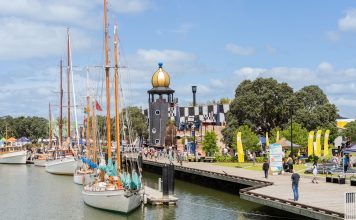
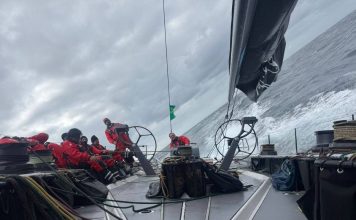
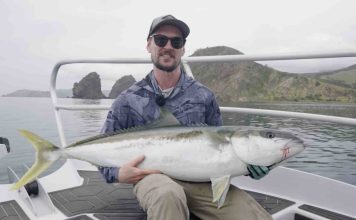
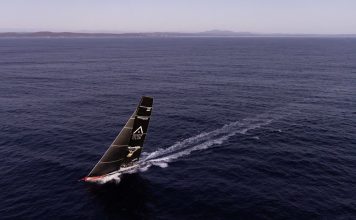
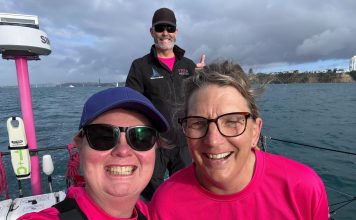
We like the design of the 34.1, but would like more performance. We like the overall length. Our old boat was a Beneteau Oceanis 321. We loved the accommodations in the 321 and stability of the boat in high winds, but we want a much faster, more competitive boat. We club race a lot. Would the First Line package with the classic mast and the performance sails make a significant improvement? Would the retractable keel be faster than the deep draft keel?